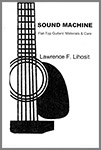Review — SOUND MACHINE by Lawrence Lihosit (Honduras)
 Sound Machine: Flat-Top Guitars’ Materials & Care
Sound Machine: Flat-Top Guitars’ Materials & Care
by Lawrence Lihosit (Honduras 1975-77)
Self-published
70 pages
May 15, 2020
$9.95 (paperback)
Reviewed by Alan Schwartz (NRPCV)
•
The title of this compact book cuts right through pretensions as in “The Art of…” / “The Craft of…” / or the “How to…” tiresome millions. Lawrence Lihosit has written a guide to the way a guitar works. Sound Machine: Flat-top Guitars’ Materials & Care explains it all from the construction to the mechanisms to where to store it at home or how to do so when you’ll be away.
He starts with how sound is produced inside the instrument when you strike a string, then provides the nomenclature for all the parts of the instrument, explains the function of the various woods used and/or combined in the body or neck of the guitar All this in an unpretentious, lively style loaded with solid knowledge, history, and love of the instrument.
For example:
Storage If you still take off your clothes at night and throw them on the floor and after clothes washing, dump those on the couch, you might want to treat your guitar differently. The best way to store your guitar is in its case, even at home. Radical changes in temperatures and humidity are a guitar’s enemy.
The author continues with details of temperature, preferable humidities, and how to contend.
Cleaning If you are a person who cooks and just leaves the dirty . . . laying around for the Good Dish Washing Fairy, this might be news to you. Everything about a guitar is based on sound. If your guitar is grimy dirty . . . it is time to clean . . .. Also, wash your hands before playing . . . and keep a clean cotton cloth in your guitar case so you can wipe down the strings after . . ..”
Abundant details about the care and feeding of your guitar(s) are included: serious stuff in a lively manner. And there’s a brief, interesting 3000-year history behind the modern Flat Top, with focus narrowing on developments in the late 19th century by C.F. Martin in Vienna. Booted out of the violin makers guild, Martin moved to the USA where he developed many of the techniques of internal bracing, adjustable neck dovetailed to the body, and reinforce soundboard (top) to spread the sound vibration and make it stronger.
His son and heir, also C.F. continued in the early 1900s to develop the guitar for the newly popular and much louder steel strings, adding an adjustable truss rod inside the neck and heavier bracing inside the body to accommodate the pressure. Out of all these improvements came the famous “Dreadnought” model in 1916.
The other companies were not asleep either. Gibson improved its own models with Martin’s innovations and a whole new corps of makers followed, including Gretsch and Harmony out of Chicago. Radio and big bands in the 1920s created a demand for louder and more modulated sound from a guitar in the rhythm section of the big bands, to cut through the brass and woodwinds. Thus was born the “archtop” guitars with “F” slots instead of a round hole, and larger sound boxes with arched backs, similar in structure to the viol family.
Martin and Gibson led the pack for many years and recently Taylor Guitar Company has taken a large market share with very good products and the savvy to talk to the consumer with a regular publication subscription.
This is a good chronology of guitar history, and a bibliography solid enough to keep the reader busy for a while complete this really laudable short book. Lots of information admirably presented. Hats off!
* This reviewer ’s gratuitous comment: a recent entry into the USA market “Eastman” produces some very good quality instruments at reasonable prices . . . flat top and carved top (hollow body electrics). See Maple St Guitars, Atlanta GA.
•
New Yorker Alan Schwartz was a professional guitarist for studio, club, and big band gigs. A Fulbright exchange professorship in Santiago, Chile allowed him to organize a performance jazz group of Peace Corps Volunteers. He owns a dozen guitars: classic, acoustic, and electric.
Thank you very much for taking the time to read and comment on this tiny book.
Looks like a must read for any guitar players. I am going to buy several copies for friends.
Thank you, Steve. Don’t be a ‘fraidy cat: post an honest review. Comments are always welcome.